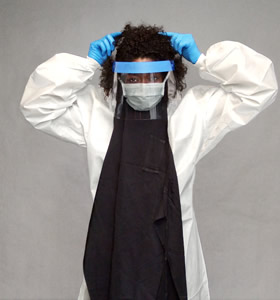News that a second nurse in Texas has been struck with the deadly Ebola virus is likely to send an unprecedented sense of alarm through the public and health care community. It also renews focus on the CDC’s recently updated Ebola infection prevention and control guidelines for U.S. hospitals.
Nurses need to now how to treat patients and prevent the virus from spreading. Here’s a summary of the CDC guidelines:
Patient protection. Suspected Ebola patients should be placed in single patient rooms that have a private bathroom. The door should be closed and hospitals should maintain a log of everyone who enters the patient’s room.
Visitors should generally not be allowed to visit patients who might have Ebola. However, exceptions could be made on a case by case basis. If a visitor is allowed, they should be screened for Ebola and should also be given instruction on precautions, hand hygiene, and how to use protective clothing.
Personal protection equipment (PPE). Everyone entering a patient’s room should wear—at the minimum—gloves, a fluid resistant or impermeable gown, eye protection and a facemask. After exiting, the PPE should be carefully removed, and hands should be sanitized.
Patient care equipment. Wherever possible, dedicated, disposable patient care equipment should be used. Non-dedicated, non-disposable medical equipment should be cleaned and disinfected according to manufacturer’s instructions and hospital policies. The use of needles and other sharps should be limited as much as possible.
Monitoring and managing potentially exposed personnel. Nurses who have skin or membrane exposure to a suspected Ebola patient’s bodily fluids or secretions should stop working immediately and wash the affected skin surfaces with soap and water. (If contact was made through a membrane, such as the eye, the nurse should irrigate with water or eyewash). The nurse should also immediately contact health authorities.
Nurses who have unprotected interaction with a person who has Ebola (for example, if a nurse isn’t wearing PPE at the time of patient contact) should be evaluated and monitored for fever twice a day for 21 days after the last known exposure.
If a nurse develops symptoms of Ebola, including fever, he or she should notify a supervisor immediately.
Every hospital should have its own policy for dealing with patients suspected of having Ebola. As we learn more about this virus, the CDC’s guidelines and recommendations will likely be updated. Stay informed so that you can know the latest about how to help control this deadly disease.
- 5 Winter Time Sleep Tips - January 23, 2015
- Ebola Prevention – Learning from Other Countries - October 16, 2014
- Preventing Ebola Infection in Nurses – CDC Guidelines - October 15, 2014



